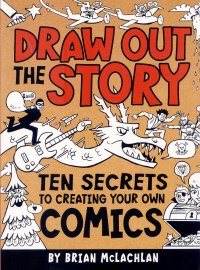| ________________
CM . . .
. Volume XX Number 14. . . .December 6, 2013
excerpt:
Cartoonist Brian McLachlan draws from (no pun intended) his many years of cartooning experience to create a practical, fun instruction book for budding comic artists. He provides 10 basic concepts, one per chapter, that apply to all comic genres, and he explains them in kid-friendly language. In the first chapter, McLachlan introduces readers to “comic grammar”, the speech balloons, caption boxes, panels and other elements which can be compared to the punctuation marks of writing. The second chapter focuses on style (using special effects and drawing tools to suit the story), genre (story elements) and format (single panel, comic strip, anthology and graphic novel, for example). Subsequent chapters provide information about icons, details such as shape, line and color, characters and setting, panels to capture expanded moments in time, and where to find inspiration. For more avid cartoonists, McLachlan discusses the differences between plots and vignettes and explains how to use metaphor and allusion. Throughout the book, he provides examples of the various concepts, and in one of the latter chapters he draws an eight-page comic adventure, then invites readers to analyze some of the panels so that they can recognize and better understand the tools that he has used. As well, McLachlan occasionally refers to popular comics to reinforce some of the concepts and to provide real-life examples of the tools employed. At the end of each chapter is a section entitled “Your Turn”. Here McLachlan lists some activities related to the concept in the chapter and asks readers to try some of them as homework or practice. For instance, in the chapter about using details, one of the tasks is to draw three rectangles and turn them into an envelope, a magazine, and a box of cereal by the addition of details, while in the chapter about generating creative ideas, one task is to choose a fictional character and draw a two-page comic about a typical day in his/her life. The strengths of this book are many. Firstly, by dividing the book into 10 chapters, each focusing on a specific “secret”, McLachlan does not overwhelm his audience; secondly, he balances the art with the importance of the writing component; and thirdly, he provides readers with a great many tips and ideas and encourages them to experiment with a variety of styles in order to find their own particular style. Attention to detail is also evident in this book, the table of contents being no exception. Here, in keeping with the comic theme, readers will find the chapter headings done in cartoon format. An index is also included in the book. Jam-packed with practical information, Draw Out the Story is sure to appeal to young cartoonists. Highly Recommended. Gail Hamilton, a former teacher-librarian, lives in Winnipeg, MB.
To comment
on this title or this review, send mail to cm@umanitoba.ca.
Copyright © the Manitoba Library Association. Reproduction for personal
use is permitted only if this copyright notice is maintained. Any
other reproduction is prohibited without permission.
NEXT REVIEW |
TABLE OF CONTENTS FOR THIS ISSUE
- December 6, 2013.
AUTHORS |
TITLES |
MEDIA REVIEWS |
PROFILES |
BACK ISSUES |
SEARCH |
CMARCHIVE |
HOME |
